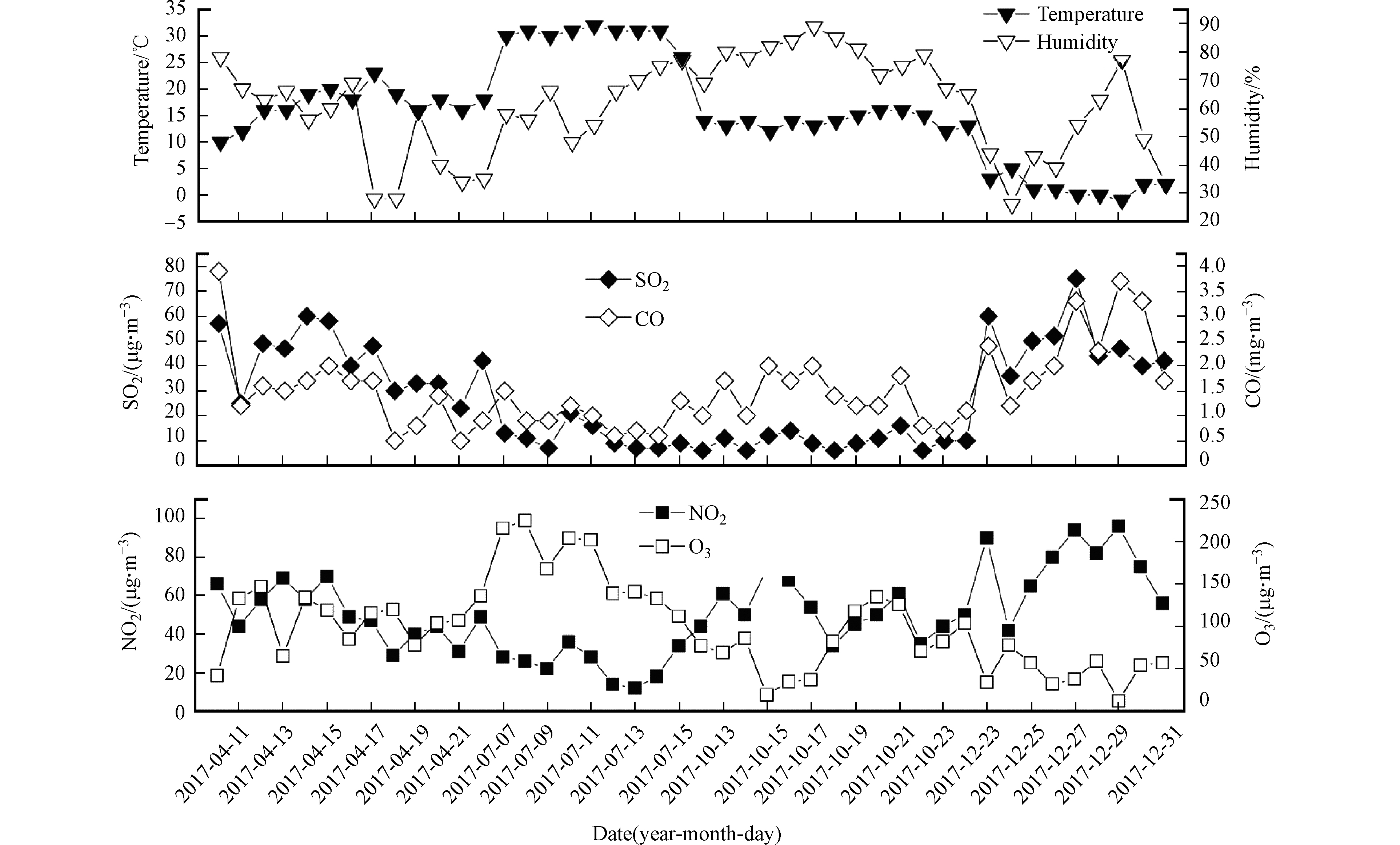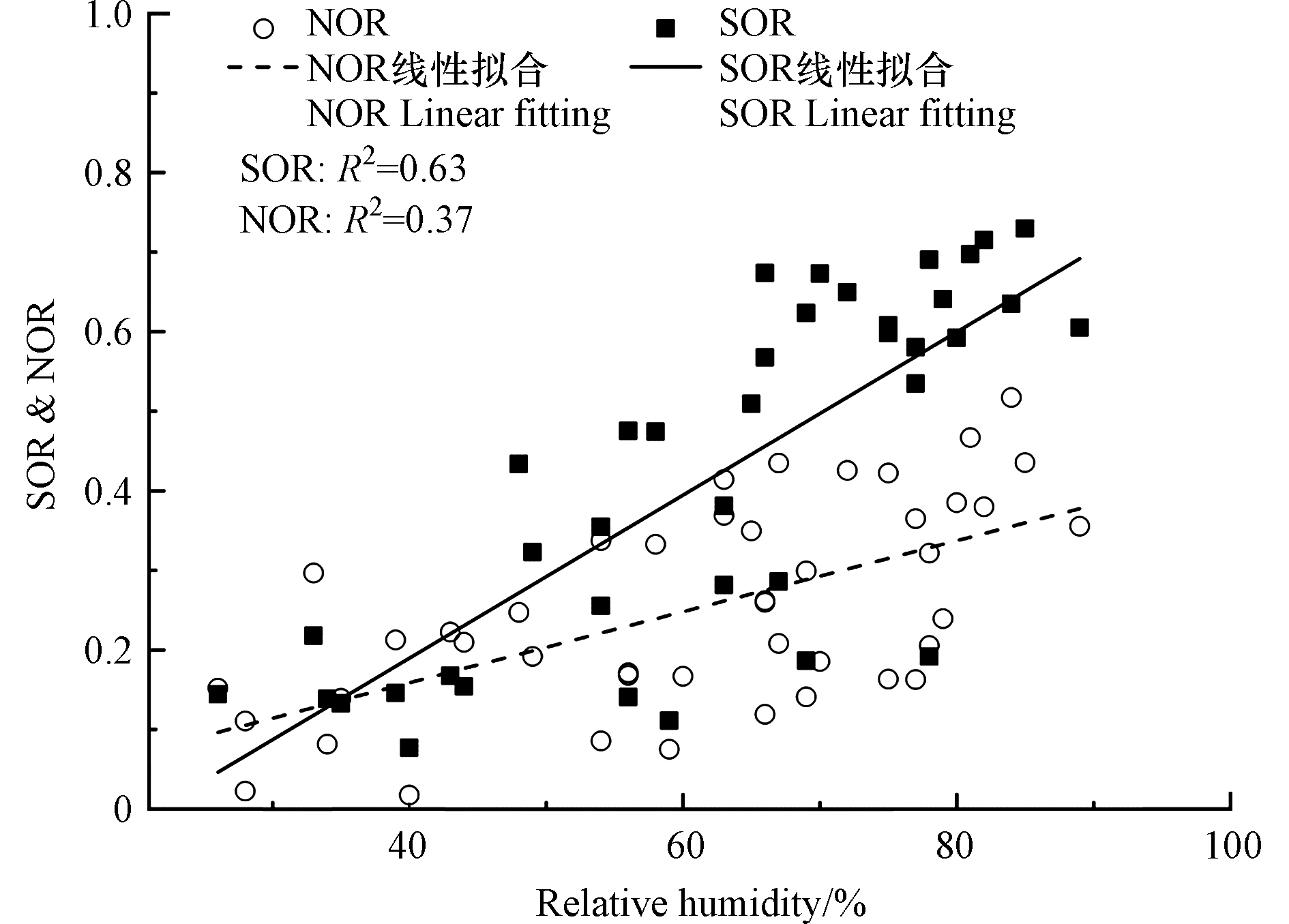-
近年来,PM2.5成为了中国大部分城市的主要污染物,PM2.5不仅会出现水体富营养化、能见度降低以及土壤酸化等环境问题,还会对人类的呼吸系统、心血管系统造成严重伤害[1-5]. 据《2017年中国生态环境状况公报》显示,大多数的城市空气质量不达标,其中只有99个地级市空气质量达标,占城市总数的29.3%[6-7].
水溶性离子是PM2.5中的主要化学组成部分[8]. 研究学者对水溶性离子的污染特征以及来源解析做了不少报道,这对治理大气环境的问题有重要的意义[9].在京津冀的水溶性离子化学特征的研究中显示,SNA(SO42−、NH4+、NO3−)是大气颗粒物中最重要的组成成分[10]. 张蕾等[11]在盘锦市秋季的水溶性离子的特征研究中,PM2.5的平均质量浓度为(52.71±19.44) μg·m−3 ,采样期间的颗粒物整体偏酸性.曹云擎等[12]对“2+26”城市一次污染过程的PM2.5的化学组分以及来源进行了研究,结果显示,北京、唐山以及太原的PM2.5本地的排放量最大,天津等18个城市为外地城市的贡献最大,济南等7个城市的外围区域的贡献最大,呈现出明显的区域性污染特征. 程渊等[13]在武汉市的水溶性离子的研究中表明,武汉市的大气存在较强的SO2向 SO42−、NO2向 NO3−转化的二次过程,主成分分析中显示,该市的水溶性离子主要来源于燃煤以及机动车排放、工业生产、扬尘等.
邯郸市位于河北省的南部,与河南、山西、山东省相邻,是京津冀主要的燃煤城市之一,高强度的污染排放导致邯郸成为颗粒物污染的频发区和重灾区,其次西部有太行山脉,它的阻挡作用导致大量的颗粒物不易扩散. 目前针对邯郸的水溶性离子的季节性变化研究相对比较少. 孟琛琛等[14]对邯郸市2013年水溶性离子进行了讨论,春、夏、秋的3个季节的PM2.5呈酸性,冬季呈碱性,并分析得出了SO42−、NO3−、Cl−的存在形式.刘召策等[15]探讨了邯郸PM2.5的光学特性,结果显示,消光系数平均值为(780.9±439.1)mol·L−1·m−1,EC(有机碳)和NH4NO3的消光系数高于其他成分. 牛红亚等[16]利用离子色谱法并分析了水溶性无机离子的特征,结果发现,SO42−、NO3−、NH4+是春夏秋冬季PM2.5中主要的成分,并且水溶性离子的来源主要为生物质燃烧和二次转化.
由于对邯郸多时间序列的研究比较有限,因此本文将利用2017年所采集的水溶性离子数据对PM2.5的污染特征以及来源解析进行较为系统的研究,为邯郸市的大气污染防治工作提供科学依据与数据支撑.
-
采样地点位于河北省邯郸市原河北工程大学行政楼楼顶(36.57°N,114.50°E),距地面高度约16 m,采样点附近无高大建筑物以及工厂,距采样点5.8 km处有大型钢厂(河钢集团邯钢公司)、火电厂和水泥厂等工业厂房,能客观地反映邯郸市的大气污染状况. 采样时间为2017年的4月、7月、10月以及12月,分别代表春夏秋冬四个季节,采集时间段为8:00—19:30(白天)、20:00—次日7:30(夜间),采样时长为11.5 h,有效采样膜数为88个.
-
PM2.5的样品采用六通道空气颗粒物采样器(Unray ZR—3930D)采集,采样流量为16.7 L·min−1,使用特氟龙膜(Teflon)分析PM2.5的质量浓度和水溶性离子的浓度. 采样前需要将Teflon膜放置在恒温恒湿箱中(温度(25±0.5)℃,湿度(RH)为30%±5%)恒温24 h以上,在电子天平(瑞士,XS205dualrange,0.01 mg)中进行称重,采样前后需要采集空白滤膜,采样后的样品放置在-18 ℃以下的冰箱.
-
使用离子色谱仪(Dionex ICS—600)对样品中的水溶性离子(阳离子:Na+、K+、Mg2+、NH4+、Ca2+;阴离子:Cl−、NO3−、SO42−)进行分析. 样品分析时,取1/2 Teflon 膜置于聚丙烯离心管中,加入20 mL 超纯水(电阻率:18.2 MΩ·cm),超声提取1 h,静置后用0.45 μm微孔水系滤头过滤,随后分析测定无机离子成分,阳离子检测采用 CS12A 色谱柱,阴离子检测采用 AS22 色谱柱[15]. 采样期间的气温、相对湿度以及气态污染物(SO2、NO2、O3、CO)等气象因子(图1)通过中国空气质量在线监测分析平台(https://www.aqistudy.cn)进行获取.
-
在观测期间,邯郸市2017年PM2.5及水溶性离子的日变化如图2所示,PM2.5浓度的日变化范围为9.4—338.64 μg·m−3,其中春夏秋季的PM2.5日变化趋势较为平缓,而冬季的变化波动比较大,变化范围为58.5—338.6 μg·m−3.PM2.5的年平均浓度为(88.08±59.08)μg·m−3,未达到《环境空气质量标准(GB 3095—2012)年均二级标准值(35 μg·m−3),超标倍数为2.3倍,高于武汉市的81.3 μg·m−3(2016—2017年)[13] 、北京的77.1 μg·m−3(2017—2018年)[17]、安阳市的85.81 μg·m−3(2018—2019年)[18]、本溪市的57.6 μg·m−3(2016年)[19],低于邯郸市的131.2 μg·m−3(2013年)[14]、95.01 μg·m−3(2016年)[16],具体情况如表1. 从季节角度,邯郸市冬季PM2.5浓度均高于上述城市,冬季天气处于静稳状态,扩散条件不利且湿度大,易于污染物的积累及二次转化,导致PM2.5浓度升高.
PM2.5的季节变化较为明显,表现出冬季[(153.9±69.5) μg·m−3]>秋季[(93.4±40.0) μg·m−3]>春季[(65.0±35.0)μg·m−3]>夏季[(41.1±14.6)μg·m−3]. 与春夏季节相比,秋冬季节在2017年10月15日—17日(AQI分别为205、214、200)、2017年10月21日(AQI为189)、2017年12月23日(AQI为188)以及2017年12月27日—30日(AQI分别为234、223、314、260)出现严重的霾污染情况,从而导致这两个季节的PM2.5的浓度严重超标. 虽然与2016年邯郸市的PM2.5浓度相比有所下降,但是与《环境空气质量标准(GB 3095—2012)日均二级标准值(75 μg·m−3)相比,超标率分别为38.5%(春)、6.3%(夏)、56.5%(秋)、88.2%(冬),主要还是由于冬季使用大量的煤取暖,从而排放出大量的颗粒物和气态前体物;夏季PM2.5的浓度低与该季节温度高,降水较多,并且太阳辐射强度大,空气中的污染物易于扩散等有关,相反,冬季大气层结构较为稳定,使污染物长期积累不易扩散,冬季温度较低,有利于NH4NO3向气态颗粒物富集[21].自从2017年12月份实施了“煤改气”的方案[22],2018年邯郸市PM2.5浓度为67 μg·m−3,同比下降18.29%,但从整体来看,污染防控工作还是面临着严峻挑战.
-
在观测期间,测得8种水溶性离子(Na+、K+、Mg2+、NH4+、Ca2+、Cl−、NO3−、SO42−)的浓度,其中NO3−>SO42−>NH4+>Cl−>K+>Ca2+>Na+>Mg2+.
总的水溶性离子(TWSII)年均浓度为(53.0±38.1)μg·m−3,对PM2.5贡献值为58.2%,其中季节特征表现为:秋季(74.3%)>夏季(60.1%)>冬季(50.9%)>春季(46.7%),高于京津冀以及周边其他城市,如北京(44.1%)[17]、郑州(36%)[23]、天津(57%)[24],由此可以说明,TWSII对邯郸市的污染有很大的贡献. TWSII与PM2.5的季节分布相同,最高值出现在冬季[(81.6±43.6)μg·m−3],最低值为夏季[(25.1±11.2)μg·m−3],秋季和春季分别为[(70.3±31.7)μg·m−3]、[(33.7±25.8)μg·m−3],平均值为[(53.0±38.1)μg·m−3],呈现出明显的季节差异性特征.
SNA是PM2.5中主要的水溶性离子且影响着PM2.5的浓度水平,其中SNA的浓度与总水溶性离子的比值分别为春季82.5%、夏季94.7%、秋季95.15%和冬季81.3%,占PM2.5的比例分别为39%、57%、71%和42%.这3种离子在不同季节也表现出了不同的变化趋势. NH4+、NO3−、SO42−多数是由NH3、NOx和SO2气态前体物经过一系列的大气物理变化转化而来的,一定程度上能反映二次污染水平[25-26],其中NO3−的平均浓度最高,最高出现在秋季(31.1 μg·m−3),最低出现在夏季(5.5 μg·m−3),其平均浓度是SO42−的1.5倍,NH4+的1.7倍,NO3−的平均浓度高于SO42−,说明邯郸市移动源对PM2.5的贡献量大于固定源.SO42−在冬季(19.1 μg·m−3)最高,春季(9.6 μg·m−3)最低,SO42−的形成主要有两种,分别为光化学过程和液相过程[27]. 由图1的气象参数可知,夏季气温和相对湿度较高,并且具有较强的大气氧化性,有利于SO42−的生成,使得SO42−的浓度在夏季较高;冬季主要以燃煤为主,导致大量的气态前体物(如SO2等)生成,大量的排放到空气中,加之一些不利的气象因素的影响,使得SO42−的浓度逐渐积累;春季SO42−的浓度低是因为采暖期结束,SO2的排放量下降,导致SO42−的浓度有所降低. NH4+通常是与NO3−和SO42−的共存的化学组分.在本研究中,NH4+的最高浓度值出现在冬季(19.1 μg·m−3),其次为秋季(15.7 μg·m−3),春季和夏季的差别不大. 在夏季高温条件下,NH4NO3 易分解成气态的硝酸和氨,导致 NH4+在夏季浓度低;冬季低温条件,稳定的大气层结构及NOx的排放增多均有利于NH4NO3的生成,因此NH4+的浓度在冬季最高[28].
K+和Cl−通常被视为生物质和煤燃烧的重要示踪物[29],两者具有相同的季节变化特征,均呈现出冬季[(1.7±0.6)μg·m−3、(9.9±3.5)μg·m−3]最高,夏季[(0.5±0.2)μg·m−3、(0.4±0.2) μg·m−3]最低的趋势,说明这两种离子可能具有相似的污染来源. Mg2+和Ca2+是土壤和沙尘的示踪物,呈现出春季高,夏季低的特征,春季风速大、湿度低、降水少,导致土壤和沙尘再悬浮,长时间富集在大气中;夏季降水多,对土壤和沙尘粒子具有清除作用,使得Mg2+和Ca2+在夏季的浓度最低.
-
颗粒物的酸碱性是研究气候和人类健康效应的重要指标,离子电荷平衡则可以反映颗粒物的酸碱性,即阴离子当量AE(anion equivalent)与阳离子当量CE(cation equivalent)的比值,若比值大于1,则说明呈现酸性;反之,则为碱性[30]. 计算公式如下:
式中,c代表离子浓度(μg·m−3),AE和CE分别代表阴离子和阳离子当量的浓度(μmol·m−3).
经计算得,邯郸市全年的AE/CE=1.09,R2=0.989,说明PM2.5呈酸性.与长白山[8]、盘锦[11]、苏州[31]PM2.5的酸碱性相同,但与郑州[7]不同. 春夏秋冬四季的AE/CE的值及所对应的R2分别为1.13(R2=0.99)、1.11(R2=0.99)、1.24(R2=0.99)、0.95(R2=0.99),由此可知,相关性良好,实验数据可靠. 根据电荷守恒原理,若PM2.5中所有离子均被检测出来,那么AE/CE回归直线的斜率应为1,但是春夏秋三季的比值均大于1,说明PM2.5为酸性,阴离子过剩,阳离子完全被中和;冬季AE /CE的比值小于1,说明大气气溶胶呈现碱性. 因此对邯郸市冬季大气污染防治中,可以根据城市的酸碱度来选择合适的治理方案.
各个离子之间的相关性不仅可以反映大气气溶的结合方式,也可以分析其污染来源.表2为不同离子之间的相关性. 从表2可以见,NH4+与NO3−、SO42−、Cl−的相关系数分别为0.909、0.916、0.695,具有显著的相关性,由此可知,NH4+与NO3−、SO42−、Cl−的结合方式可能为NH4NO3、(NH4)2SO4、NH4HSO4和NH4Cl.其中K+与Cl−也呈现出较强的显著性,相关系数为0.86;Mg2+和Ca2+相关系数为0.841,由此说明它们的来源可能一致.
-
在大气气溶胶中,NH4+主要以(NH4)2SO4、NH4NO3和NH4Cl的形式存在,NH4+首先与SO42−结合生成(NH4)2SO4或NH4HSO4,然后剩余的NH4+将依次结合 NO3−或Cl−,形成NH4NO3 或 NH4Cl[18]. 为了进一步研究铵盐的存在方式,将采用两种方法进行计算.若NH4+完全被中和为SO42−,即铵盐主要以NH4NO3和(NH4)2SO4的形式存在,则用公式3计算NH4+的值;如果没有完全中和为SO42−,铵盐的存在方式为NH4NO3和NH4HSO4,用公式4计算NH4+的值.式中[NH4+]、[SO42−]、[NO3−]分别代表3种离子的质量浓度.
计算结果如图3所示,NH4+实际值与计算值的相关性较强(R2>0.9). 若离散点分布在直线1∶1的下方,说明计算值被低估;若离散点分布在直线上,说明计算值与实际值相吻合.
在图4可以看出,被完全转化为SO42−的离散点更接近1∶1的直线,说明春夏秋三个季节的铵盐主要以NH4NO3和(NH4)2SO4两种形式存在;冬季两种方式的离散点均在直线的下方,说明铵盐并不是以上述两种情况的形式存在,而是以其他形式存在,由于冬季的Cl−的浓度较高,是其他季节的4倍,因此此时的铵盐存在方式可能为NH4Cl.
-
SO42−、NO3−都是水溶性离子中主要的离子,硫氧转化率(SOR)和氮氧转化率(NOR)可以用来表征SO2和NO2向SO42−、NO3−转化的程度[32].计算公式为:
式中的[SO42−]、[NO3−]分别代表SO42−、NO3−的质量浓度(μg·m−3),[SO2]、[NO2]分别代表SO2、NO2的质量浓度(μg·m−3).
SOR和NOR的比值越高,二次转化的程度也就越高[32]. 经计算得,SOR 全年值均在0.1以上,年均值为0.39,说明存在SO2向SO42−转化的过程.SOR在秋季最高(0.61),其次为夏季(0.54),冬季(0.26),春季最低(0.19),夏秋较高的SOR值表明高温高湿、强氧化性的的天气有利于SO42−的生成. NOR年均值为0.25,低于SOR的年均值,NOR表现为秋季最高,冬季次之,春夏最低的季节特征,与前文的NO3−浓度的季节变化一致. 本文的SOR和NOR都比较高,是SO2和NO2进行了较强的二次转化的结果. 邯郸市冬季仍然以燃煤供暖为主,机动车所排放大量的NO2和SO2,使得SNA的浓度升高,加重了对环境的污染,导致城市出现大规模的灰霾天气.
由于邯郸市的污染还是比较严重的,因此SOR、NOR也会随污染情况的变化而出现改变. 参考我国的《环境空气质量指数技术规定》中的标准,将整个研究阶段分为3个部分,清洁[ρ(PM2.5)<75 μg·m−3]、轻中度污染[75 μg·m−3<ρ(PM2.5)<150 μg·m−3]、重度污染[ρ(PM2.5)>150 μg·m−3],其中3部分的天数为24 d、16 d、4 d,占观测天数的54.5%、36.3%、9.2%.清洁、轻中度污染和重度污染天SOR的平均值为0.37、0.43、0.45,NOR的平均值分别为0.25、0.25、0.28.显然轻中度污染和重度污染时的SOR值高于清洁天的SOR值,又重度污染天比轻中度污染天硫的转化率更高,这可能与重度污染期间的相对湿度有关,相对湿度高有利于SO2的非均相氧化反应. 清洁天和轻中度污染天的NOR平均值相似,低于重度污染的NOR值,说明重度污染较于清洁天和轻中度污染天有更多的NO2向NO3的转化.
-
上述可知,SOR整体上高于NOR的值,可能与相对湿度有关,因此对SOR、NOR与相对湿度进行了进一步的研究. SOR、NOR与相对湿度的线性拟合的结果如图4所示,可知SOR、NOR与相对湿度都呈正相关,两者的相关系数(R2)分别为0.63、0.37,说明相对湿度对于SO2、NO2向硫酸盐和硝酸盐之间的转化起着促进的作用,相对湿度越高,越容易转化. 另外SOR的相关系数高于NOR,说明SOR对相对湿度较为敏感,可能与空气中大量的水分与污染物的结合,从而促进二次转化生成硫酸盐有关[33].
-
本研究采用的的是SPSS19软件对PM2.5中水溶性离子进行来源解析,主要采用主成分分析法(PCA),结果如表3所示. 主成分分析法主要是提取大量的组分数据的特征分量,在对水溶性离子的来源解析方面有着广泛的应用.在所有因子中选取特征值大于1的3个因子作为主要因子,解释了80.657%的总变量.因子1中载荷较大的组分为NH4+、SO42−、NO3−,贡献率为49.096%,特征值为5.401,由前文可知主要是NH4+、SO42−、NO3−由气态前体物二次转化形成的. 因子2贡献率为18.547%,累计方差贡献率为67.643%,特征值为2.040,其中Mg2+和Ca2+的载荷量较大,这两种离子通常被视为扬尘的示踪物.因子3贡献率为13.014%,累计方差贡献率为80.657%,特征为1.432,K+和Cl−载荷量较大,K+和Cl−通常是生物质燃烧和煤燃烧的示踪物,该因子可以代表燃烧源.因此,邯郸市的污染来源可以为二次转化、扬尘源及燃烧源.
-
(1)邯郸市的PM2.5的年平均浓度为(88.08±59.08) μg·m−3,季节变化特征表现为冬季>秋季>春季>夏季. 水溶性离子的年均浓度为(53.0±38.1) μg·m−3,对PM2.5的贡献值为58.2%,8种水溶性离子的浓度高低顺序为NO3−>SO42−>NH4+>Cl−>K+>Ca2+>Na+>Mg2+.
(2)SNA是水溶性离子中主要的成分. 邯郸市全年的AE/CE=1.09,R2=0.989,PM2.5呈酸性. 春夏秋季PM2.5呈酸性,冬季呈碱性. 相关性分析中可知:NH4+与NO3−、SO42−、Cl−之间具有显著的相关性.
(3)春、夏、秋季的铵盐主要以NH4NO3和(NH4)2SO4两种形式存在,冬季铵盐存在方式则为NH4Cl.
(4)邯郸市SOR、NOR在秋季为最高;在轻中度污染和重度污染的情况下SO2的转化率更高,而NO2在重度污染的情况下更容易转化. 同时,相对湿度也能对SO2、NO2的转化产生促进作用.
(5)邯郸市的污染来源主要为二次转化生成、扬尘以及生物质燃烧和煤燃烧.
邯郸市大气细颗粒物中水溶性离子的污染特征及来源解析
Pollution characteristics and source of water-soluble ions in atmospheric fine particles in Handan City
-
摘要: 为研究邯郸市大气细颗粒物中水溶性离子的季节变化特征及来源,于2017年采集了大气PM2.5样品,并结合气象要素(温度、相对湿度)、气态污染物(SO2、NO2、O3)浓度对水溶性无机离子进行分析. 结果显示,2017年邯郸市PM2.5年均浓度为(88.08±59.08)μg·m−3,季节变化特征为冬季>秋季>春季>夏季;8种水溶性离子年均浓度为(53.0±38.1) μg·m−3,对PM2.5的贡献值为58.2%,各离子的浓度高低顺序为
${\rm{NO}}_3^{-} $ >${\rm{SO}}_4^{2-} $ >${\rm{NH}}_4^{+} $ >Cl−>K+>Ca2+>Na+>Mg2+;SNA(${\rm{SO}}_4^{2-} $ 、${\rm{NO}}_3^{-} $ 、${\rm{NH}}_4^{+} $ )为水溶性离子的重要组成部分;通过对颗粒物的酸碱度与相关性分析,春、夏、秋季PM2.5呈酸性,冬季呈碱性;春、夏、秋季${\rm{NH}}_4^{+} $ 的存在形态为NH4NO3和(NH4)2SO4,冬季${\rm{NH}}_4^{+} $ 存在形式为NH4Cl;湿度对硫氧转化率和氮氧转化率有一定的促进作用.二次转化生成、燃煤、生物质燃烧和扬尘为水溶性离子主要的来源.-
关键词:
- 邯郸市 /
- PM2.5 /
- 水溶性离子 /
- 硫酸盐、硝酸盐及铵盐 /
- 来源
Abstract: In order to explore the characteristics and sources of water-soluble ions in PM2.5 in Handan, China, PM2.5 samples were collected in 2017, combined with meteorological elements (temperature, relative humidity), gaseous pollutants (SO2, NO2, O3) and water-soluble ions were analyzed. The results showed that the average concentration of PM2.5 in Handan was (88.08±59.08)μg·m−3 in 2017, and its seasonal variation was characterized by winter> autumn> spring> summer. The annual average concentration of 8 water-soluble ions was (53.0±38.1)μg·m−3, and the contribution value to PM2.5 was 58.2%. The order of each ion concentration was${\rm{NO}}_3^{-} $ >${\rm{SO}}_4^{2-} $ >NH4+>Cl−>K+>Ca2+> Na+>Mg2+. SNA (${\rm{SO}}_4^{2-} $ 、${\rm{NO}}_3^{-} $ 、${\rm{NH}}_4^{+} $ ) was the important component of TWSII. Through the analysis of the pH and correlation , PM2.5 was acidic in spring, summer and autumn, and alkaline in winter.${\rm{NH}}_4^{+} $ mainly existed in the form of NH4NO3 and(NH4)2SO4 in spring, summer, autumn. Besides,${\rm{NH}}_4^{+} $ mainly existed in the form of NH4Cl in winter. Humidity had a certain role in promoting the conversion rate of sulfur and oxygen and the conversion rate of nitrogen and oxygen. The result of principal component analysis indicated that secondary transformation, coal combustion, biomass burning and dust were the main sources of the water-soluble ions in Handan during sampling periods.-
Key words:
- Handan City /
- PM2.5 /
- water-soluble ions /
- SNA(SO42-、NO3-、NH4+) /
- source
-

-
表 1 不同城市的PM2.5浓度对比(μg·m−3)
Table 1. Comparison of PM2.5 concentration in different cities
城市City 采样日期Sampling date 春季Spring 夏季Summer 秋季Autumn 冬季Winter 全年Annua 北京[17] 2017.12—2018.12 102.9 54.7 75.4 75.8 77.1 唐山[20] 2016 70.3 64.5 74.8 89.1 74.6 石家庄[20] 2016 65.1 60.5 111.8 140.2 94.6 安阳[18] 2018.04—2019.01 75.9 46.9 90.5 104.8 85.8 本溪[19] 2016.01—2016.10 42.6 40.9 58.5 88.2 57.6 邯郸[14,16] 2013.01—2013.102016.04—2016.12 66.299.8 84.277.6 128.184.4 230.8122.5 131.295.0 本研究 2017.04—2017.12 64.9 41.1 93.4 153.9 88.0 表 2 PM2.5中各离子之间的相关系数矩阵
Table 2. Correlation coefficient matrix between ions in PM2.5
离子Ions Na+ NH4+ K+ Mg2+ Ca2+ Cl− SO42− NO3− Na+ 1 NH4+ 0.402** 1 K+ 0.618** 0.652** 1 Mg2+ 0.388** −0.012 0.394** 1 Ca2+ 0.241* −0.114 0.228* 0.841** 1 Cl− 0.576** 0.695** 0.860** 0.213* 0.142 1 SO42− 0.401** 0.916** 0.555* −0.024 −0.149 0.534* 1 NO3− 0.292** 0.909** 0.518** 0.010 −0.088 0.520** 0.725** 1 注: *表示相关性在0.05是水平显著(双侧),**表示相关性在0.01水平显著(双侧).
Note: * indicates that the correlation is significant at 0.05 level (bilateral), and ** indicates that the correlation is significant at 0.01 level (bilateral).表 3 主成分旋转因子载荷矩阵
Table 3. Principal Factor Rotation Factor Load Matrix
离子组分Ionic components 因子1Factor 1 因子2Factor 2 因子3Factor 3 Na+ 0.726 0.529 0.001 NH4+ 0.974 0.051 0.081 K+ 0.693 0.609 0.138 Mg2+ 0.070 0.882 −0.236 Ca2+ 0.019 0.944 0.045 Cl− 0.743 0.494 0.142 SO42- 0.910 −0.052 0.020 NO3− 0.857 0.029 −0.001 方差贡献率Variance contribution rate 49.096% 18.547% 13.014% 累计方差贡献率Cumulative variance contribution rate 49.096% 67.643% 80.657% 特征值Eigenvalues 5.401 2.040 1.432 来源Source 二次转化生成 扬尘 生物质及煤燃烧 注:黑体字为该因子中载荷较大的组分载荷量.
Note: The boldface is the load of the component with larger load in this factor. -
[1] BEI N F, ZHAO L N, WU J R, et al. Impact of sea-land and mountain-valley circulations on the air pollution in Beijing-Tian-Hebei (BTH): A case study [J]. Environmental Pollution, 2018, 234: 429-438. doi: 10.1016/j.envpol.2017.11.066 [2] YU S S, LIU W J, XU Y S, et al. Characteristics and oxidative potential of atmospheric PM2.5 in Beijing: Source apportionment and seasonal variation [J]. Science of the Total Environment, 2019, 650: 277-287. doi: 10.1016/j.scitotenv.2018.09.021 [3] ZHANG H, YUAN H O, LIU X H, et al. Impact of synoptic weather patterns on 24 h average PM2.5 concentrations in the North China Plain during 2013–2017 [J]. Science of the Total Environment, 2018, 627: 200-210. doi: 10.1016/j.scitotenv.2018.01.248 [4] SONG C, HE J, WU L, et al. Health burden attributable to ambient PM2.5 in China [J]. Environmental Pollution, 2017, 223: 575-586. doi: 10.1016/j.envpol.2017.01.060 [5] 李莉, 安静宇, 严茹莎. 基于细颗粒物来源追踪技术的2013年12月上海市严重污染过程的PM2.5的源贡献分析 [J]. 环境科学, 2015, 36(10): 3543-3553. LI L, JING Y Y, YAN R S. Analysis of PM2.5 source contribution based on fine particle source tracking technology in Shanghai in December 2013 [J]. Environmental Science, 2015, 36(10): 3543-3553(in Chinese).
[6] QIAO T, ZHAO M F, XIU G L, et al. Simultaneous monitoring andcompositions analysis of PM1 and PM2.5 in Shanghai: Implications for characterization of haze pollution and source apportionment [J]. Science of the Total Environment, 2016, 557: 386-394. [7] 赵庆炎, 姜楠, 燕启社, 等. 郑州市夏、秋季大气颗粒物中水溶性无机离子质量浓度及粒径分布特征 [J]. 环境科学, 2018, 39(11): 4866-4875. ZHAO Q Y, JIANG N, YAN Q S, et al. Mass concentration and particle size distribution characteristics of water-soluble inorganic ions in atmospheric particles in summer and autumn in Zhengzhou city [J]. Environmental Science, 2018, 39(11): 4866-4875(in Chinese).
[8] 赵亚南, 王跃思, 温天雪, 等. 长白山PM2.5中水溶性离子季节变化特征研究 [J]. 环境科学, 2014, 35(1): 9-14. ZHAO Y N, WANG Y S, WEN T X, et al. Study on the seasonal variation characteristics of water-soluble ions in PM2.5 in Changbai Mountain [J]. Environmental Science, 2014, 35(1): 9-14(in Chinese).
[9] 胡晓峰, 张翔, 柳笑, 等. 西宁市PM2.5水溶性无机离子特征及其来源解析 [J]. 环境科学研究, 2019, 32(7): 1179-1186. HU X F, ZHANG X, LIU X, et al. The characteristics and sources of PM2.5 water-soluble inorganic ions in Xining [J]. Environmental Science Research, 2019, 32(7): 1179-1186(in Chinese).
[10] SUN Y L, WANG Z F, FU P Q, et al. The impact of relativehumidity onaerosol composition and evolution processes during wintertime in Beijing, China [J]. Atmospheric Environment, 2013, 77: 927-934. doi: 10.1016/j.atmosenv.2013.06.019 [11] 张蕾, 姬亚芹, 王士宝, 等. 盘锦市冬季PM2.5水溶性离子特征及来源分析 [J]. 环境科学, 2018, 39(6): 2521-2527. ZHANG L, JI Y Q, WANG S B, et al. Analysis of the characteristics and sources of water-soluble ions of PM2.5 in Panjin city in winter [J]. Environmental Science, 2018, 39(6): 2521-2527(in Chinese).
[12] 曹云擎, 王体健, 韩军彩, 等. “2+26”城市一次污染过程PM2.5化学组分和来源解析研究 [J]. 环境科学学报, 2020, 40(2): 361-372. CAO Y Q, WANG T J, HAN J C, et al. Analysis of the chemical components and sources of PM2.5 in the “2+26” urban primary pollution process [J]. Journal of Environmental Science, 2020, 40(2): 361-372(in Chinese).
[13] 程渊, 吴建会, 毕晓辉, 等. 武汉市大气PM2.5中水溶性离子污染特征及来源 [J]. 环境科学学报, 2019, 39(1): 191-198. CHENG Y, WU J H, BI X H, et al. Characteristics and sources of water-soluble ion pollution in atmospheric PM2.5 in Wuhan [J]. Journal of Environmental Sciences, 2019, 39(1): 191-198(in Chinese).
[14] 孟琛琛, 王丽涛, 张芬芬, 等. 邯郸市PM2.5中水溶性无机离子污染特征及来源解析 [J]. 环境科学学报, 2015, 35(11): 3443-3451. MENG C C, WANG L T, ZHANG F F, et al. Pollution characteristics and source analysis of water-soluble inorganic ions in PM2.5 in Handan City [J]. Journal of Environmental Science, 2015, 35(11): 3443-3451(in Chinese).
[15] 刘召策,袁 琦,胡 伟,等.邯郸市冬季一次霾过程中细颗粒物化学组分的污染特征及消光贡献[J].地球化学,2020,49(03):298-305. LIU Z C, YUAN Q, HU W, et al. Pollution characteristics and extinction contribution of chemical composition in fine particulate matter during a winter haze episode in Handan[J]. Geochimica, 2020, 49(03): 298-305 .
[16] 牛红亚, 杨旗, 刘召策, 等. 燃煤工业城市大气细颗粒物中水溶性无机离子的季节变化特征及来源解析——以邯郸市为例 [J]. 中国环境监测, 2020, 36(1): 26-33. NIU H Y, YANG Q, LIU Z C, et al. Seasonal variation characteristics and source analysis of water-soluble inorganic ions in atmospheric fine particles in coal-burning industrial cities——taking Handan city as an example [J]. China Environmental Monitoring, 2020, 36(1): 26-33(in Chinese).
[17] 李欢, 唐贵谦, 张军科, 等. 2017~2018年北京大气PM2.5中水溶性无机离子特征[J]. 环境科学, 2020, 41(10): 4364-4373. LI H, TANG G Q, ZHANG J K, et al. Characteristics of water-soluble inorganic ions in atmospheric PM2.5 in Beijing from 2017 to 2018[J]. Environmental Science, 2020, 41(10): 4364-4373.
[18] 孙有昌, 姜楠, 王申博, 等. 安阳市大气PM2.5中水溶性离子季节特征及来源解析 [J]. 环境科学, 2020, 41(1): 75-81. SUN Y C, JIANG N, WANG S B, et al. Seasonal characteristics and source analysis of water-soluble ions in atmospheric PM2.5 in Anyang City [J]. Environmental Science, 2020, 41(1): 75-81(in Chinese).
[19] 张敬巧, 王涵, 胡君, 等. 本溪市PM2.5中水溶性离子季节性变化特征及来源分析 [J]. 环境科学研究, 2019, 32(2): 246-252. ZHANG J Q, WANG H, HU J, et al. Seasonal variation characteristics and source analysis of water-soluble ions in PM2.5 in Benxi City [J]. Environmental Science Research, 2019, 32(2): 246-252(in Chinese).
[20] 贾佳, 韩力慧, 程水源, 等. 京津冀区域PM2.5及二次无机组分污染特征研究 [J]. 中国环境科学, 2018, 38(3): 801-811. doi: 10.3969/j.issn.1000-6923.2018.03.001 JIA J, HAN L H, CHENG S Y, et al. Study on pollution characteristics of PM2.5 and secondary inorganic components in Beijing-Tianjin-Hebei region [J]. Chinese Environmental Science, 2018, 38(3): 801-811(in Chinese). doi: 10.3969/j.issn.1000-6923.2018.03.001
[21] WANG S X, XING J, CHATANI S, et al. Verification of anthropogenicemissions of China by satellite and ground observations [J]. Atmospheric Environment, 2011, 45(35): 6347-6358. doi: 10.1016/j.atmosenv.2011.08.054 [22] 邯郸市生态环境局. 环境观察: “煤改气”要弹好钢琴[EB/OL]. http://sthj.hd.gov.cn/main/detail/68993, 2017-12-20. Handan ecological and environment bureau. Environmental observation: “Coal to Gas” must play the piano [EB/OL]. http://sthj.hd.gov.cn/main/detail/68993, 2017-12-20.
[23] 闫广轩, 张靖雯, 雷豪杰, 等. 郑州市大气细颗粒物中水溶性离子季节性变化特征及其源解析 [J]. 环境科学, 2019, 40(4): 1545-1552. YAN G X, ZHANG J W, LEI H J, et al. Seasonal variation characteristics and source analysis of water-soluble ions in atmospheric fine particles in zhengzhou city [J]. Environmental Science, 2019, 40(4): 1545-1552(in Chinese).
[24] 牛宏宏, 王宝庆, 刘博薇, 等. 天津冬季PM2.5中水溶性无机离子污染特征研究 [J]. 环境污染与防治, 2019, 41(5): 592-595. NIU H H, WANG B Q, LIU B W, et al. Study on pollution characteristics of water-soluble inorganic ions in PM2.5 in Tianjin in winter [J]. Environmental Pollution and Control, 2019, 41(5): 592-595(in Chinese).
[25] WANG Y, ZHUANG G S, ZHANG X Y, et al. The ion chemistry, seasonal cycle, and sources of PM2.5 and TSP aerosol in Shanghai [J]. Atmospheric Environment, 2005, 40(16): 2935-2952. [26] VOUTSA D, SAMARA C, MANOLI E, et al. Ionic composition of PM2.5 at urban sites of northern Greece: Secondary inorganic aerosol formation [J]. Environmental Science & Pollution Research, 2013, 21(7): 4995-5006. [27] XIE S, GU A Z, CEN T, et al. The effect and mechanism of urban fine particulate matter (PM2.5) on horizontal transfer of plasmid-mediated antimicrobial resistance genes [J]. Science of the Total Environment, 2019, 683(SEP.15): 116-123. [28] WANG H, AN J, SHEN L, et al. Mechanism for the formation and microphysical characteristics of submicron aerosol during heavy haze pollution episode in the Yangtze River Delta, China [J]. Science of the Total Environment, 2014, 490: 501-508. doi: 10.1016/j.scitotenv.2014.05.009 [29] 张棕巍, 胡恭任, 于瑞莲, 等. 厦门市大气PM2.5中水溶性离子污染特征及来源解析 [J]. 中国环境科学, 2016, 36(7): 1947-1954. doi: 10.3969/j.issn.1000-6923.2016.07.004 ZHANG Z W, HU G R, YU R L, et al. Characteristics and source analysis of water-soluble ion pollution in atmospheric PM2.5 in Xiamen city [J]. Chinese Journal of Environmental Science, 2016, 36(7): 1947-1954(in Chinese). doi: 10.3969/j.issn.1000-6923.2016.07.004
[30] ZHANG T, CAO J J, TIE X X, et al. Water-soluble ions in atmospheric aerosols measured in Xi'an, China: Seasonal variations and sources [J]. Atmospheric research, 2011, 102(1/2): 110-119. [31] 王念飞, 陈阳, 郝庆菊, 等. 苏州市PM2.5中水溶性离子的季节变化及来源分析 [J]. 环境科学, 2016, 37(12): 4482-4489. WANG N F, CHEN Y, HAO Q J, et al. Seasonal change and source analysis of water-soluble ions in PM2.5 in Suzhou City [J]. Environmental Science, 2016, 37(12): 4482-4489(in Chinese).
[32] SHON Z H, GHOSH S, KIM K H, et al. Analysis of water-soluble ions and their precursor gases over diurnal cycle [J]. Atmospheric Research, 2013, 132-133(oct.-no): 309-321. [33] HUANG X, LIU Z, ZHANG J, et al. Seasonal variation and secondary formation of size-segregated aerosol water-soluble inorganic ions during pollution episodes in Beijing [J]. Atmospheric Research, 2016, 168(FEB.): 70-79. -



















 下载:
下载:




